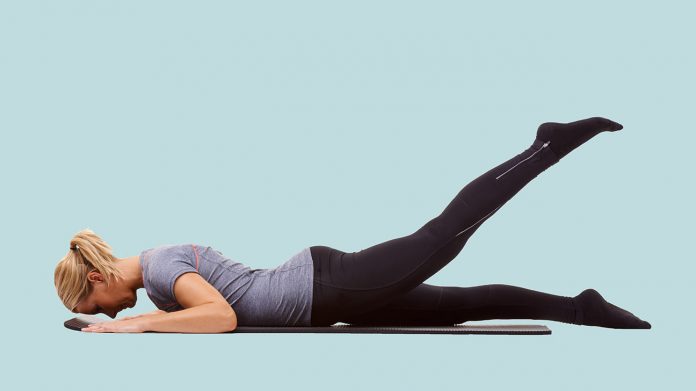When it comes to exercising, it pays to work your butt off. It also pays to work your butt. Period.
As one of the biggest muscle groups in your body, your glutes plays several important roles, including stabilizing your hips, back, and lower half, and powering your entire body through both difficult workouts and everyday life. Strengthening your butt will help it accomplish these crucial tasks—and more—efficiently and effectively.
Here to help with said strengthening is NYC-based celeb-favorite gym Dogpound, which posted an Instagram video last week of trainer Emily Samuel demoing a five-part glute-focused circuit workout.
“I wanted to give people something they can do anywhere on the go,” Samuel tells SELF of the inspiration behind this circuit. And she achieved that with the help of a small, but mighty tool: the looped resistance band. “I’m really into bands,” adds Samuel, praising their versatility, effectiveness in challenging all types of skill levels, and convenience compared to bigger, bulkier workout tools.
This particular banded circuit, as mentioned, focuses on the glutes. “Your glutes are where you get most of your power and strength from,” Samuel says of the importance of incorporating butt-focused exercises into your routine. But not all butt exercises are the same. Many popular glute moves, like squats or forward and reverse lunges, mainly target the gluteus maximus (the biggest muscle of the butt). Samuel’s banded combo of moves, on the other hand, targets all three glute muscles, which include your glute max, plus your gluteus minimus and gluteus medius.
That’s important because the two smaller muscles, which form your side butt, serve several big functions. First, they work together to move your leg away from the center of the body and also help with rotation of the thigh. Because of those functions, they can help you change direction quickly, explains Samuel, which is important in sports with lots of side-to-side movements (like soccer and basketball), as well as everyday life (say you need to quickly step to the side to dodge a moving object, for example). They also help keep your hip joint strong and stable, Stephanie Mansour, Chicago-based certified personal trainer, previously told SELF. Lastly, these two muscles, though smaller than the glute max, are a crucial part of how your glutes function effectively and efficiently as one muscle group. By focusing on these smaller muscles, you can improve the power and capabilities of the glute unit as a whole.
And back to that band: With this specific sequence, it ups the strengthening benefits of each move and adds in extra hip stability work, says Samuel. Any weaknesses or instability in the hip joint can translate to problems up into the lower back and down into the knee and ankle, which is why it’s important to incorporate hip-stabilizing moves, like these banded glute exercises, into your regular routine.
On top of all the glute and hip work, this circuit also works your hamstrings, lower back, and core, she adds.
Here’s how to do the five-part circuit:
To start, grab a looped resistance band that’s appropriate for you. If possible, have several options on hand, in case the resistance becomes too much or too little midway through. (ICYW, Samuel is using a medium-strength band.) You’ll do the following series three to four times through, resting 20 to 30 seconds in between each move, and taking a minute break in between each round.
Banded Walking Squat Jump — 12 to 15 reps
- Put the band just above your knees and stand with your feet slightly wider than shoulder-width apart.
- Bend your knees slightly and swing your arms to wind up and jump as far forward as you can. Make sure to press your knees out against the band so they don’t cave in.
- As you land, clasp your hands in front of your body and push you butt back and bend your knees to sink into a wide squat.
- Quickly jump your feet together, standing up halfway as you do, and then jump your feet apart again to sink into another wide squat. Do this two more times, moving back toward the starting location with each squat.
- One rep equals one big jump forward plus three smaller jumps back.
- Do 12 to 15 reps.
These jumps will get your heart rate going, says Samuel, and also activate your glutes. As you jump, keep your knees in line with your toes—don’t let your knees cave inward. This will ensure the strengthening focus stays on your glutes and will also protect your knee joint from unnecessary stress.
Lastly, keep your chest up and stay low as you jump. “You should never fully stand up,” says Samuel. This ensures your glutes are constantly under tension throughout the reps and thus ups the strengthening challenge of the move.
Fire Hydrant to Leg Kickbacks — 12 to 15 reps
- Place the band just above your knees.
- Start on all fours with your shoulders stacked over your wrists and your hips over your knees. This is the starting position.
- Without shifting your hips, lift your right knee up and out to the side until your thigh is parallel with the floor. (You may not be able to lift that high, and that’s OK—lift as high as your mobility allows.) Pause for a second, and then slowly return to the starting position.
- From here, extend and lift your right leg straight out behind you, pointing your toes and squeezing your glutes as you do so. Your right hip to your right foot should form one long, straight line. Slowly return to the starting position.
- This is 1 rep. Do 12 to 15 reps.
- Switch sides and repeat.
The first part of the move—the fire hydrant portion—will target your glute medius and minimus, and the kickback will engage your lower back, says Samuel. As you perform the kickbacks, make sure your extended leg stays at hip-level. Don’t raise it any higher, says Samuel, as this could cause you to arch your back and cause discomfort or pain. If you feel discomfort in your lower back, don’t lift your leg quite as high.
Glute Bridge Presses — 12 to 15 reps
- Place the band just above your knees. Lie on your back with your hands at your sides, knees bent, and feet flat on the floor shoulder-width apart.
- Press through your heels and squeeze your glutes and core to lift your hips a few inches off the floor. Holding this position, push your knees out to the sides.
- Bring your knees back to hip-distance apart and then lower your hips back down until your glutes are hovering just above the floor (don’t rest them on the floor). This is 1 rep.
- Do 12 to 15 reps.
This move works your glute maximus, lower back, and hamstrings. The abducting motion at the top of the bridge (when you press your knees apart) works your glute medius as well. Make sure you continue driving through your heels as you perform the reps. This will ensure you are working your backside (glutes, lower back, and hamstrings), rather than your quads and knees, says Samuel. Engage your core throughout to ensure you don’t over-arch your low back, she adds.
Donkey Kicks — 12 to 15 reps
- Place the band just above your knees. Start on all fours with your wrists under your shoulders and knees under your hips.
- Extend your left leg straight out behind you, pointing your toe and squeezing your glutes as you do so. Your left hip to your left foot should form one long, straight line.
- Pause for a moment in this extended position and then bend your left knee to draw your leg back into the starting position. Try to keep your left knee hovering several inches above the floor instead of letting it rest. This is 1 rep.
- Do 12 to 15 reps. Switch sides and repeat.
This is essentially the same as move number two, minus the fire hydrants, says Samuel. It lets you really target your glute maximus and engages your core (specifically your lower back muscles).
Staggered-Stance Banded Deadlifts — 15 reps
- Stand up straight with your feet hip-distance apart and stagger your stance, placing your left foot in front of your right a few inches.
- Bend forward at your waist to loop the band under the ball of your left foot.
- Grab the band with both hands and stand all the way up. There will be significant tension on the band. Press your shoulder blades down and together to keep your chest lifted.
- Lift your right heel up and bend your right knee. Your left foot should remain flat and firmly planted on the floor, with the majority of your body weight in the left heel. Your left leg should stay straight.
- From here, hinge forward at your waist, press your butt back as far as you can, and slightly bend your left knee as you lower your torso down and forward, running your palms down your thighs.
- As you lower, engage your core and keep your back flat (not arched or rounded). The tension on the band will loosen as you get closer to the floor. Stop when you feel a stretch in your hamstrings.
- Press through your left heel to reverse the movement and return to standing. Squeeze your glutes at the top of the movement. This is 1 rep.
- Do 15 reps. Switch sides and repeat.
These deadlifts will hit the same muscles as the glute bridges—primarily your lower back, glute maximus, and hamstrings, says Samuel.

























